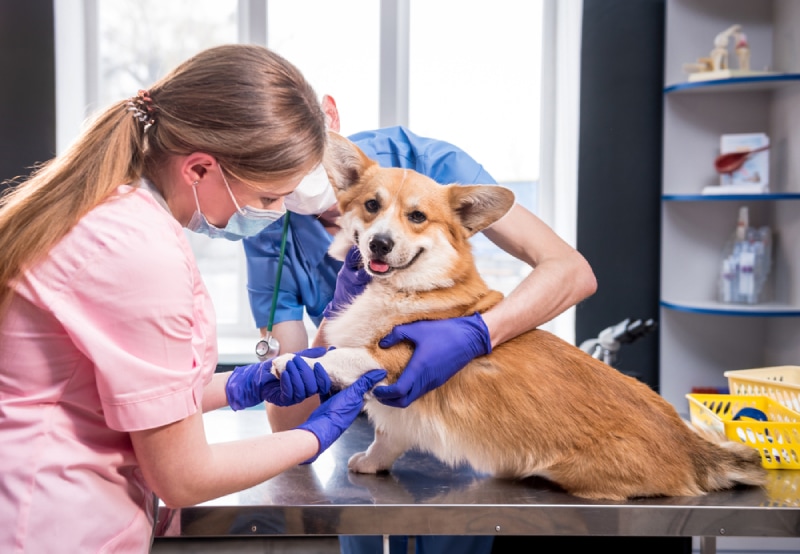- October 6, 2023
Pododermatitis in Dogs: Causes & Care Guide (Vet Answer)



The information is current and up-to-date in accordance with the latest veterinarian research.
Pododermatitis is an inflammatory condition affecting the skin of the feet in dogs. There are different presentations, and they can vary greatly in severity. It can be extremely painful and irritating for dogs. It is also known as Canine Pedal Furunculosis.
The condition causes sore swollen feet which can be itchy and red. Often the feet bleed and the dog can develop a limp. It is a relatively common condition seen in dogs. It can be an effect of other skin issues dogs may encounter.
The condition often causes swollen, red, itchy feet, which can become painful over time. In severe cases, it can result in dogs becoming lame. This article will discuss the common signs, causes, and treatment options for pododermatitis in the dog.

What Is Pododermatitis in Dogs?
Pododermatitis, by definition, is inflammation of the skin of the paw. It can affect all tissue in and around the paw including the nail, nail beds, interdigital spaces, footpads, and the skin. It is a common condition seen by vets. It may affect just one foot, or all of them at once.
Depending on the underlying cause and the health status of the dog, clinical signs can resolve on their own, be intermittent, or be more of a chronic issue.
The condition can also be referred to as Furunculosis or Folliculitis. Many different factors can influence the development and progression of the disease. It can be a complicated problem that often is challenging to treat. Pododermatitis is not technically a diagnosis. It is a clinical presentation determined by particular signs. It can present on its own, or alongside other skin or systemic clinical issues. There are many causes and factors that contribute to and exacerbate the situation.

What Are the Signs of Pododermatitis in Dogs?
The most common clinical sign owners will notice is lameness and red swollen paws. It can be more difficult to spot depending on your dog’s coat and the length of their hair. It is good practice to start examining your dog’s paws after walks from when they are puppies. This way, they are used to someone lifting and touching their paws. You will be able to identify any problems quickly and get an appointment with your vet at the earliest opportunity. It is also a good idea to rinse your dog’s paws after muddy walks as mud caked onto the paws can cause issues and contribute to the development of pododermatitis.
The most common clinical signs witnessed with pododermatitis include:
- Lameness of affected limbs
- Swelling of paws
- Redness
- Itchy paws
- Sores/skin lesions
- Licking/biting of paws excessively
- Purulent discharge
- Hair loss
- Blisters/scabs/abscesses on paws
- Thickening of skin
- Changes in pigmentation
- Ulceration of the paws
- Nodules on digits
- Inflammation of nail beds
What Are the Causes of Pododermatitis in Dogs?
There are many different causes of pododermatitis in the dog.
The more common ones are listed below:
- Infections: This can be from bacteria, fungi, parasites, or yeast.
- Immune-mediated disorders: This can include Systemic Lupus erythematosus and Pemphigus Foliaceous.
- Conformation: The anatomy of the paws can play a role. Dogs that are larger and heavier may have excessively splayed feet. This alters the weight-bearing load to parts of the feet with more hair on. This in turn causes inflammation of the hair follicles.
- Obesity: If your dog is heavier than it should be, this can contribute to the development of pododermatitis. This is due to the fact that abnormal weight bearing and the distribution of weight through the feet will be altered.
- Tumors affecting the areas: For example, squamous cell carcinomas, mast cell tumors, or melanomas.
- Allergic skin disease: Including food sensitivities, contact dermatitis, atopy, and seasonal allergies.
- Hormonal disorders: Such as hypothyroidism and hyperadrenocorticism
- Metabolic disease: For example, hepatocutaneous syndrome.
- Contact dermatitis: From exposure to irritants.
- Behavioral issues: Such as overgrooming/licking/chewing paws.
- Trauma: From accidents, excessive exercise, and clipper rash.
- Foreign bodies: Such as grass seeds, glass segments, or splinters.
Diagnosis of Pododermatitis in Dogs
Diagnosis may be straightforward or very complicated depending on what the underlying cause is. Your vet will begin by taking a full clinical history and examining your dog. If they decide there are issues with the skin, they can perform further testing including hair plucks, tape impressions, smears, skin scrapings, biopsies, fungal culture, and bacterial culture, if deemed necessary. Sometimes imaging is required if, for example, a foreign body is suspected. X-rays, CT, or MRI can be useful in these circumstances. Cytology can be performed in-house if your vets have a microscope or samples can be sent away to an external lab.
Things that may be seen on the cytological exam include:
- Bacteria
- Parasites
- Yeast
- Fungi
- Inflammatory cells
Skin scrapes and hair plucks allow for rapid detection of parasites. A full clinical history will be required by your vet and is crucial to determining the underlying cause.
Your vet will ask questions such as:
- Are skin lesions limited to the paws, or spread around the body?
- What treatments have been used previously and were they successful?
- What sort of environment is your dog walked in? (Farmland, near rivers/lakes, etc.)
- Are clinical signs seen all year round or are they seasonal?
- What is your dog fed? (Including treats)
- What is your dog’s travel history?
- Are there any other underlying medical issues?
How Do I Care for a Dog with Pododermatitis?

Treatment of pododermatitis in dogs largely depends on the cause of the condition.
Infections are treated with antibiotics, led by culture and sensitivity results. Deep infections will require a lengthy course of antibiotics, your vet will advise you on dosage and the duration of the course. Parasite infestations are treated with the appropriate parasite drugs.
Foreign bodies can be removed under sedation or full general anesthetic depending on the location and type of foreign body present.
Causes due to the anatomy or conformation of the foot are more challenging to treat as there is no direct cure. Usually, an attempt is made to manage these cases and clinical signs are treated when they present. Management may include boots to protect the foot and alter the load on the pads, regular foot bathing, and changing the activity level of the dog and the terrain on which they are walked. Pain relief and anti-inflammatory medication may also play an important role in the treatment and management of this condition.
Physiotherapy and hydrotherapy may be advised, and laser therapy can be used in some practices. Sometimes surgery can be used as a last resort to remove digits or fuse toe webs together. These are salvage procedures and need to be discussed in depth with your vet before considering them.

Frequently Asked Questions (FAQs)
Which breeds are predisposed to developing pododermatitis?
Canine Pododermatitis is more commonly seen in large breeds and bulldog breeds. It is thought that this is because they have short, tough hairs on the skin covering their feet which can easily get driven into the deep layers of the skin. Breeds commonly affected include Saint Bernards, Great Danes, English Bulldogs, English Bull Terriers, and Staffordshire Bull Terriers.
Is pododermatitis painful for dogs?
Pododermatitis usually causes a great deal of discomfort and pain in dogs. It can vary in severity, so some dogs may not suffer as much as others, however, many dogs become lame, and owners can see visible signs of suffering.
Does pododermatitis in dogs resolve on its own?
The severity of pododermatitis can vary greatly in dogs. Depending on the underlying cause, lesions can resolve spontaneously on their own without treatment, or they may require lots of veterinary intervention for the dog to get relief.

Conclusion
Pododermatitis is a debilitating disease that is very commonly seen in dogs. If caught early, with appropriate treatment initiated promptly, the prognosis is very good. Depending on the underlying cause, treatment may be lengthy and, in some instances, management as opposed to a cure is the only option.
Featured Image Credit: YAKOBCHUK VIACHESLAV, Shutterstock
Tags
What do you think?
Related Articles

New Puppy Checklist: Gear You’ll Need for Your New Dog
Getting a new puppy is really exciting, but before you welcome them home, it’s important to prepare your space for them. Since puppies need a

How Big Do Mini Poodles Get? Vet Reviewed Average Weight & Growth Chart – Dogster
The information is current and up-to-date in accordance with the latest veterinarian research. Learn more » When you buy a Miniature Poodle, you might not

Can Police Dogs Smell Nicotine? Vet Verified Facts & Info – Dogster
The information is current and up-to-date in accordance with the latest veterinarian research. Learn more » While cigarette sales have been declining steadily for decades,

How Old Is 5 in Dog Years? Vet-Approved Guide to Each Size of Dog – Dogster
The information is current and up-to-date in accordance with the latest veterinarian research. Learn more » A common method for calculating a dog’s age is

